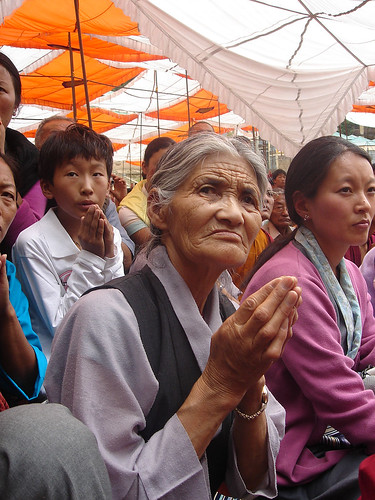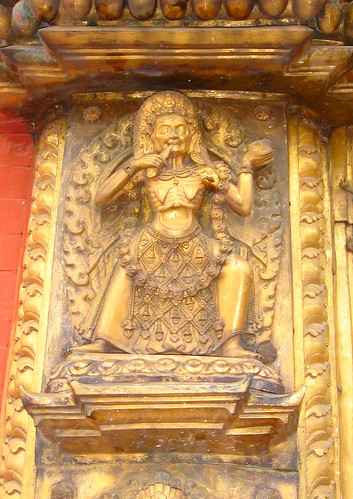At least, I think that is how one would say "New house puja" in Nepali. On Saturday, Raju and I walked out to Dallu (a neighborhood beneath the  famous Buddhist heritage site Swayambhunath stupa) to the home of Sarvaghya Bajracharya, the eldest brother of Raju's dance guru Prajwalratna Bajracharya. (There were six children in the family. At about 40 years, Prajwal Ji is the youngest.)
famous Buddhist heritage site Swayambhunath stupa) to the home of Sarvaghya Bajracharya, the eldest brother of Raju's dance guru Prajwalratna Bajracharya. (There were six children in the family. At about 40 years, Prajwal Ji is the youngest.)
Sarvaghya is a Bajracharya by family/caste, and a "guruju" by trade. That is, he is an itinerant Newar Buddhist priest, going round to various Vihars or Buddhist temples (formerly monasteries long ago), performing ceremonies and reading ancient sutras as called upon.(photo above: Newar Buddhist women prepare to worship the Prajnaparamita sutra at Kwa Bahal, Patan)
It was pitch black on the streets, as has become the norm these days. A few shopfronts stayed open with people congregating round candles and oil lamps. As if the people dwelling right on the open sewer of the Bagmati River weren't medieval enough, the lamplights reinforced my feeling that Nepal is going back into literal Dark Ages.
Like most urban Nepali dwellings, the residence was cramped and dark. The dim battery powered light showed the walls painted in a lurid turquoise. Sarvaghya sat on his bed (as guests we were given proper chairs, always a sign of respect). That afternoon, Mr Bajracharya had just been to a conclave of 21 other Bajracharya priests, at the Bidyeshwori temple just up the hill (one of my favourites - the home of AkashYogini or the Flying Space Vajrayogini). The Buddhist community had honored 21 selected acting priests for their services. He held up a handsomely framed certificate that was in Newari language, but rendered in Devanagiri script, which means that I could sound out the words but had little idea what they meant.
Mr Bajracharya was very quiet, but understood more of my Sanskrit- and Nepali-sprinkled English than he let on. Raju acted as translator but often the priest understood my questions without translation.
I realized this was an ideal person to help inaugurate my new flat, and asked Raju to invite him to perform a New House Puja. He agreed, then we had a discussion about which exact puja of the dozens he knew would be appropriate. Sarvaghya decided something called "Kalasha puja" was ideal. The reason? Tara Puja is great, too, he said, but it is some three hours long. The Kalasha puja is "only" one and a half hours. "the main aim of the kalasha puja is to make the deity present in the kalasha by means of sadhana and then through the abhisheka of the kalasha bring about participation in nirvana itself." (JK Locke, 1980)
We discussed where to get the necessary ingredients (I gave a 500Nrs -- about $7 USD - advance for the supplies - most likely rice, flowers, incense, various fruits and foods and oil lamps) and added that I wanted to get the classic Newar Buddhist Panch-Buddha signboard, as seen over countless doorways in Patan, to install over the entrance. Deluxe ones are available on wooden board; more transportable ones are on paper, pasted up like posters and renewed every so often. I guess I will blend all my South Asian influences and also have the lemon-and-green-chili charm strung up over the doorway, as well as a garland of mango leaves in south Indian style! Oh and don't forget the Kollam. That is going to be one crowded doorway for a few days.
It also remained for me to choose my
Ishtadevata (Tibetan "Yidam") or personal protector deity to invoke at the puja. I have to acquire an image (ideally a thangka or bronze statue) to be present.
Vajrayogini is my personal favourite, but seemed a bit incendiary for a house-blessing. Maybe
Avalokiteshwara, the 1000-armed benevolent Buddha now believed to be incarnated by HH the Dalai Lama. Then again Avalokiteshwara is, technically speaking, not a Yidam but a bodhisattva.
And the way things have been going lately, maybe we should invite at least one very strong Dipala or
Protector Deity.Then I asked Sarvaghya to choose a
Muhurttam for me, or the most auspicious, appropriate day and time for the ceremony. He reached over his shoulder to the wall behind, where a long, rectangular paper brochure hung. It was a Nepali ephemeris, a sort of almanac designed for just such a purpose - to indicate the phases and "houses" of the moon, and appropriate dates for various ceremonies but every activity imaginable (planting, marriage, operations, applying for jobs and so on).
The ideal time and date was determined to be at 9AM Tuesday the 17th of February, on Ashtami (the 8th day of the waning moon).
As we left the darkness and went back out into even greater darkness, I reflected - rather cornily I admit - on the conditions of Nepal generally these days.
All Darkness, no light, and no power. Blankets of air pollution choking us off from the redeeming views of Himalayas, ground pollution (in the form of uncollected g

arbage), incessant noise pollution, unspeakable water pollution. The five elements of
air, space, water, earth and fire all unrepentantly violated.
(All right, I am not sure exactly how Fire is being violated; give me a minute, I will come up with something. Burning plastic garbage is pretty bad.) On the way back to town we stopped at the
Bidhyeshwori temple to pay a visit to the Space Yogini, flying through the ether with legs like wings. (my picture at right)




































"Why didn't Slumdog Millionaire also show middle-class, prosperous India? The west just wants to perpetuate the image of Indian poverty." --
The movie did depict modern, middle-class, glass-front India- I remember finding the scenes in the flat-screen TV bungalow with security guard such a contrast with the slum scenes. The film does show that India has changed, and is changing. A character also says, “see the slums where we grew up? now it’s all high-rise housing.”
The call centre scenes were also filled with educated, well-dressed middle class youth. Middle-class “new India” was not the sole focus, but it was represented.
Director Danny Boyle is experiencing “the burden of representation” — what every artist, in film or other media, encounters when portraying or addressing an historically underrepresented people, nation or topic. The (usually well-meaning) artist is unfairly expected to redress every mis-representation of the topic that has occurred throughout the centuries, all in one two-hour film, 30 minute sitcom or 500 page book.
So let’s all look forward to AR Rahman’s Oscar win and more!
Mere desh mahan.
Related reading: